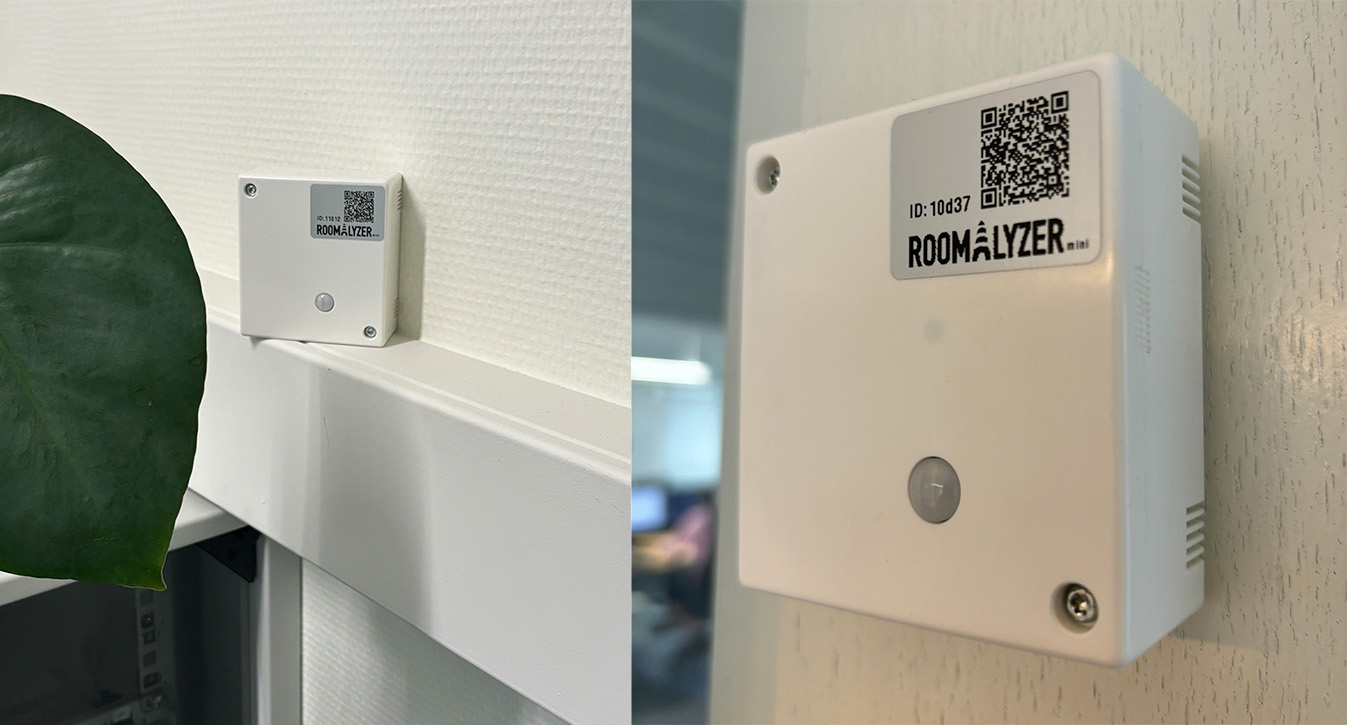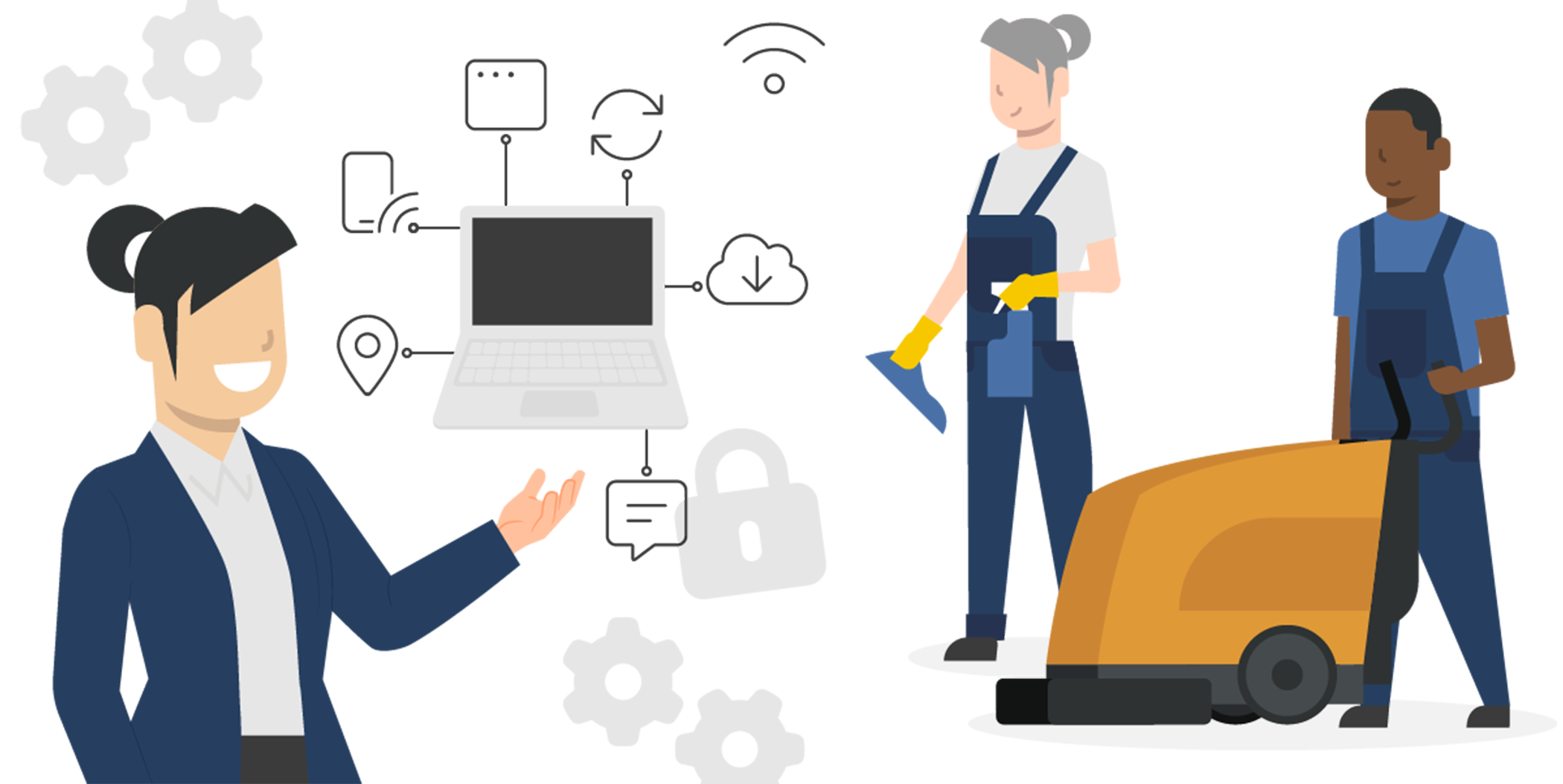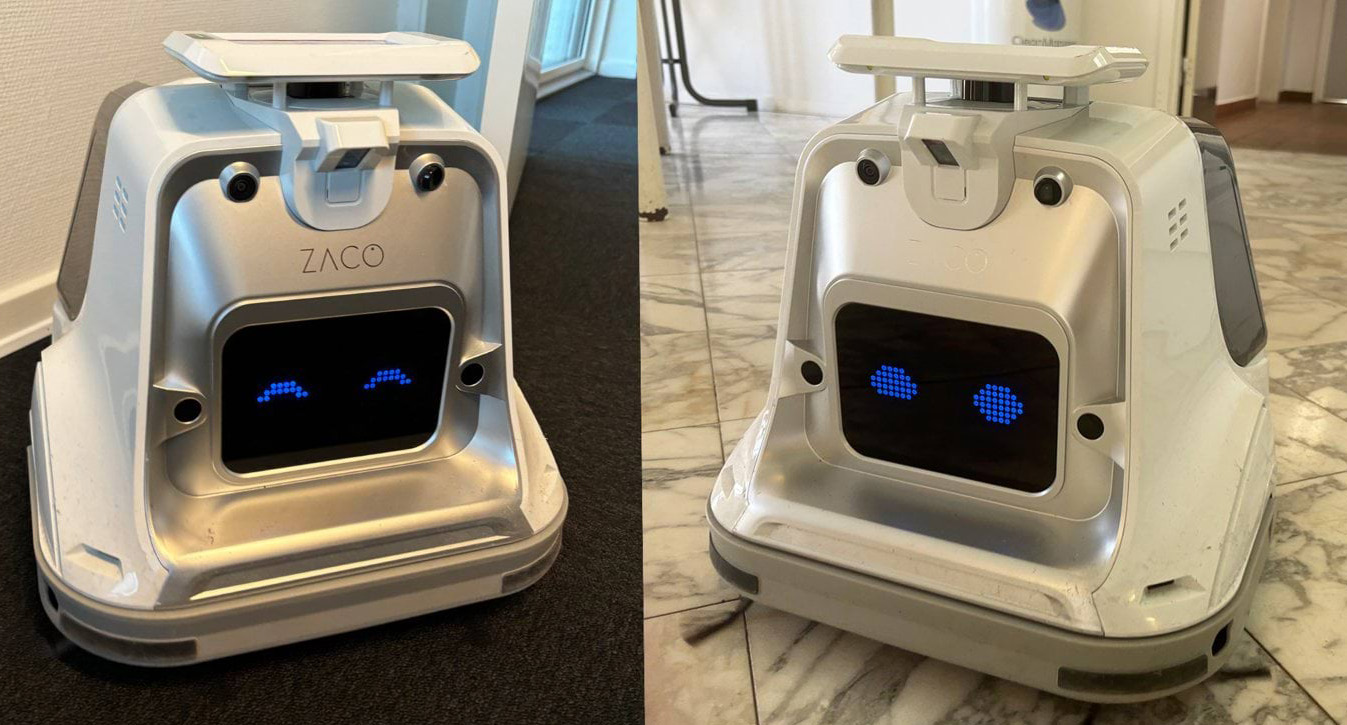At CleanManager, we develop cleaning company software and work every day to make workflows smarter. We are also curious about how new technologies can support planning and documentation. To explore whether sensor technology could ease the workload for our own cleaning staff and optimise operations, we decided to test it in our offices.
In this article, we share our experiences – the benefits we observed, the challenges we faced, and practical recommendations for anyone considering investing in sensor technology.
Technology Must Work in Practice — That Includes Sensors
Technically speaking, sensors are part of what is known as the Internet of Things (IoT). For a cleaning company, this simply means that they are small, wireless devices that automatically send data – without cables and without the need for complicated IT.
Sensors send notifications automatically. For example, when a meeting room hasn’t been used at all, when an area has been marked as cleaned, or when humidity levels indicate that extra attention is needed. This way, you save time, get documentation of the work carried out, and can be confident that your clients receive the service they expect – without having to check everything yourself.
Why Did We Choose Sensors?
We were curious to see whether real-time data could give us new insights into how our meeting rooms and shared spaces were actually being used. This, to determine whether that knowledge could help us adjust cleaning schedules to avoid spending time and resources unnecessarily. It wasn’t about fixing something that didn’t work, but about exploring the possibilities of the technology.
Our main goals in testing sensor technology were:
Can we avoid cleaning empty rooms
We wanted to explore whether sensor data could provide a better basis for planning and collaboration.
Can we ease the workload for staff and free up time for other tasks?
We wanted to investigate whether measuring temperature, movement, and humidity could help reduce unnecessary cleaning tasks – and in turn free up time for quality control and other important work.
How can sensor technology create value for our clients?
When new technology enters the market, it can be difficult to know whether it truly makes a difference in day-to-day operations and on the bottom line. That’s why we test new solutions ourselves – to see how they work in practice and to identify any challenges along the way.
We wanted to explore how sensors could be integrated into a cleaning schedule in practice, and whether they could genuinely make a difference in our own office environment.
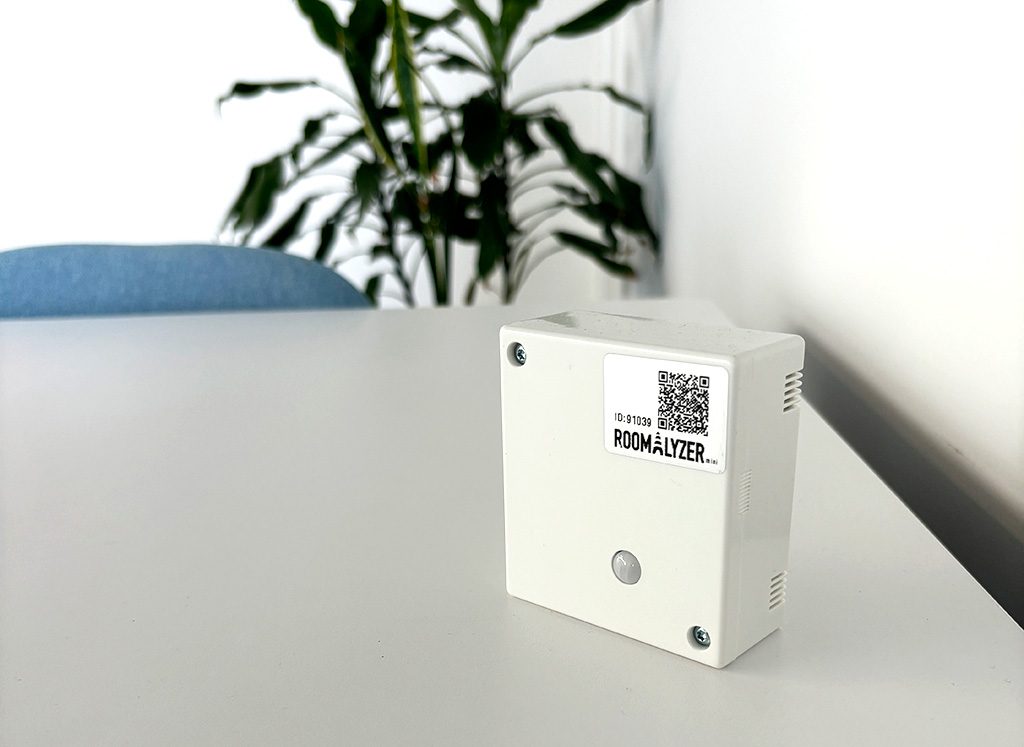
What Can Sensor Technology Do?
We used a model that measures temperature, humidity, and movement. The sensor requires no local setup or Wi-Fi, and once activated, it automatically sends data via a low-frequency network. All data is displayed in a simple browser dashboard and does not require additional installations or apps.
The sensor measures:
- Temperature
- Humidity
- Movement (presence)
What Happens with Our Data?
- Data is displayed automatically in a web browser.
- The sensors are not connected to Wi-Fi, which means no data is lost if the internet connection is interrupted or unstable.
- The sensors have no cameras and do not record personal data.
The sensor’s visual dashboard quickly shows which areas have been used and where cleaning may not be needed.
How We Implemented the Sensors
Using sensors isn’t just a matter of setting them up and letting them measure. A successful implementation requires careful planning and testing. First, we had to ensure that the sensors could be integrated into daily operations, work alongside existing routines, and deliver meaningful data without disrupting staff or processes.
Placement and coverage: We tested different wall positions to ensure optimal coverage of both indoor climate and movements. The sensor was placed vertically at eye level (around 1.2–1.5 m), away from direct sunlight, corners, ventilation outlets, or heat sources to avoid inaccurate readings.
Field of view for motion detection (PIR): In some rooms, movement was not registered correctly because furniture or other objects blocked the sensor’s line of sight. It was therefore necessary to find positions with a clear view of central areas, such as doorways, so that the presence signal was accurate. This means the implementation phase requires sensors to be installed in a way that matches the specific conditions of the office space.
Activation and battery: The sensors are activated with a magnetic touch. Although they have a long battery life (several years with normal use), it still requires attention to plan maintenance intervals and ensure proper activation.
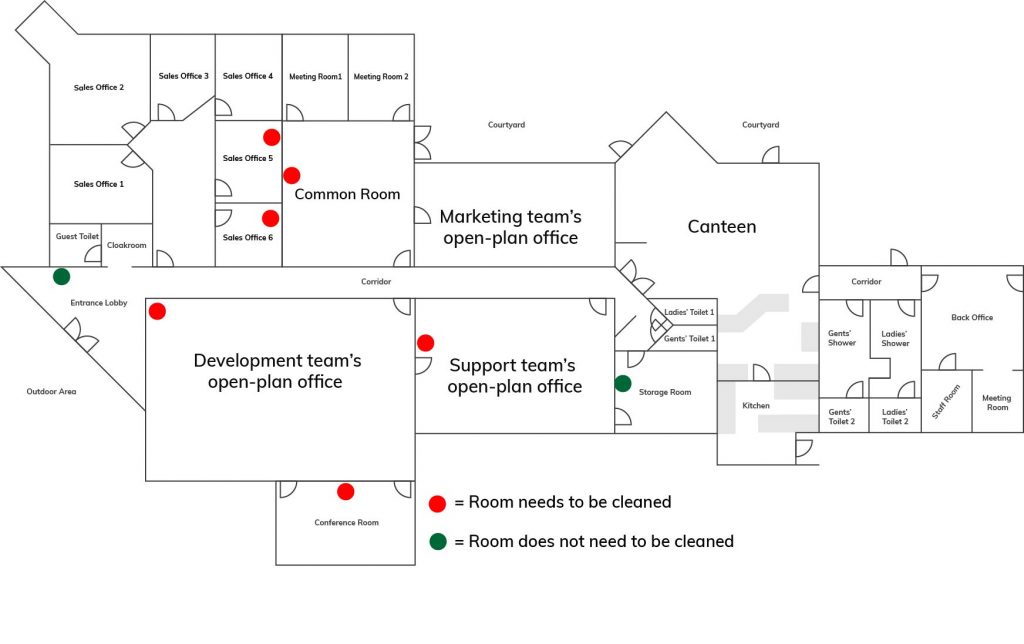
The Implementation Experience
We placed sensors in meeting rooms, larger offices, and common areas to gain insight into how much the spaces were actually used, to support the cleaning staff, and at the same time to collect indoor climate data. All measurements were gathered in a single dashboard, providing a quick overview without technical hassle. The setup was straightforward, with no need for IT support.
We chose a small, discreet sensor that measures both indoor climate and presence. There are several versions available, allowing you to select the model that best suits your needs. Our choice of sensor required minimal power and was ready to send data automatically at fixed intervals – and immediately in case of significant changes.
No matter where we placed it, the sensor worked straight away, even without Wi-Fi or local network setup, as long as it wasn’t fully enclosed in a shielded area. This made installation simple, with no need to worry about cables or technical configurations.
Reading the collected data doesn’t require an app. Instead, everything is displayed in a browser. For cleaning staff, this means they can open a map, instantly see which areas have had the most activity, and know exactly where cleaning is needed.
All collected data is available to administrators via login. From there, reports on indoor climate and usage patterns can be generated, making it easy to track developments over time.
Summing Up the Implementation
A successful implementation, however, is about more than just technology – it also requires change management. Cleaning staff need to be involved from the very beginning so they understand how sensor data can support their work rather than complicate it. When staff experience that data helps them prioritise tasks and avoid unnecessary trips to empty rooms, the technology becomes a tool that truly makes sense in daily operations.
Discover the way of change management in our article, From Technology Scepticism to Success with Change Management.
Our Steps in Implementing the Sensors
1. Mapping daily operations
We assessed how the sensors could be integrated into our routines and provide useful data without disrupting staff or processes.
2. Placement and setup
We tested different wall positions and identified the most accurate spots – vertically at eye level, with a clear view of central areas in the room.
3. Calibration and testing
In the initial phase, we monitored the data and adjusted placement whenever furniture or other conditions blocked accurate detection of movement or climate.
4. Operation and maintenance
The sensors were activated with a magnet, and we planned maintenance in line with battery life. Data was accessed via a browser and reports, giving both cleaning staff and administrators a clear overview.
Small Insights — Great Value: Our Experience with Sensors
The use of sensors quickly gave us some clear advantages. We gained a more accurate picture of how our rooms were actually being used, rather than basing cleaning on assumptions. This meant we could adjust schedules, avoid cleaning empty rooms, and instead free up time for other tasks. At the same time, the measurements of temperature and humidity provided insight into the indoor climate, which can be used to prevent mould and create a healthier working environment.
However, implementation also required adjustments. Placement was crucial. We had to experiment to find the spots where the motion sensors could correctly register room usage. In some cases, furniture or walls blocked the signal, which made the readings inaccurate until we moved the sensor. This showed that the technology works best when adapted to its surroundings.
Another challenge was understanding the data. Although the sensors provide simple graphs and reports, it still required an effort to ensure that the cleaning staff could use the information in their daily work. That’s why involvement and dialogue were an important part of the process, so the data became a real support rather than just an extra source of information.
On the positive side, we experienced that the technology created a more transparent internal dialogue. The data clearly showed which rooms were used and which stood empty, making it easier to adjust cleaning efforts. It reduced unnecessary tasks and supported a more flexible working environment.
A major advantage is that the sensors work constantly in the background without interference – they don’t take “sick days”, require minimal maintenance, and deliver reliable measurements around the clock. In the long run, this can contribute both to a healthier working environment and more efficient use of resources.
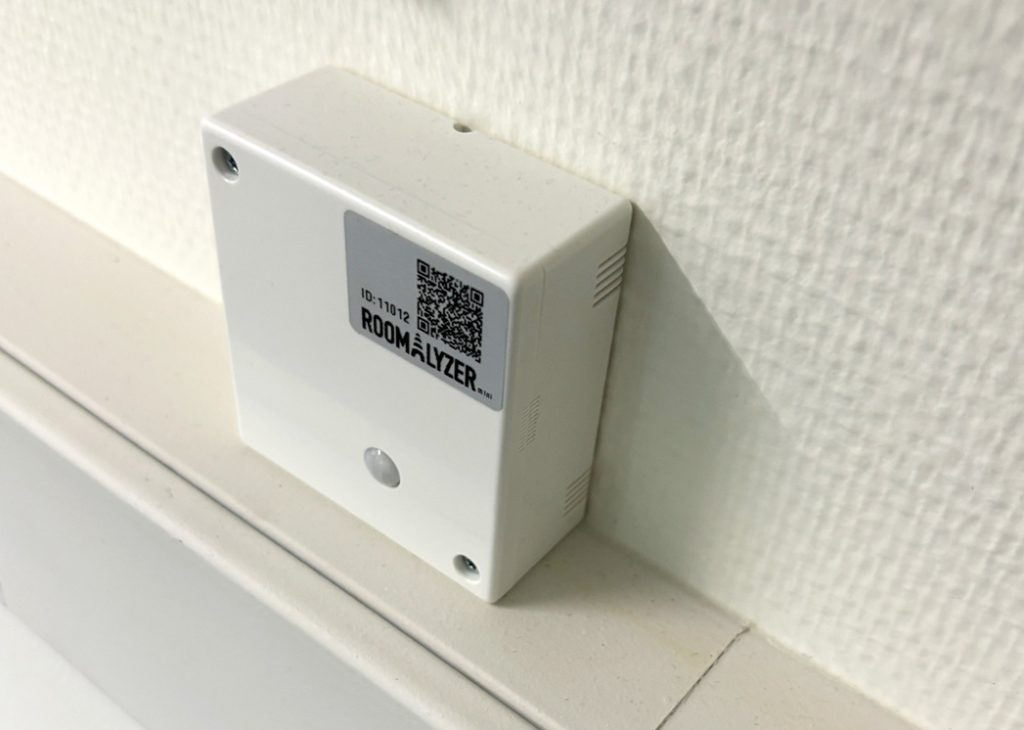
Insights from Our Experience
Most of the data we collected matched our expectations – a positive sign that our existing routines align well with actual room usage. But the sensors also revealed that one room was used far less than we had thought. This insight sparked an internal discussion about cleaning needs and whether we should adjust our schedule so that resources could be directed to where they create the most value. It shows how even small insights can lead to concrete improvements in daily operations.
Such insights are difficult to gain through observation alone but become clear when working with visual data. This makes it easier to make decisions and hold informed discussions – both internally and with the cleaning staff.
The visualisations helped create a shared understanding, which in itself is an important point. On the dashboard, we could see a set of specific measurements from the conference room: the temperature was around 22.9 °C, while the humidity was 63.7%. The sensor also showed that the room was vacant, and the battery status was stable. The coverage indicated a strong signal, so data transmission worked smoothly.
Over time, the figures were presented as graphs, giving a quick overview of developments: variations in temperature and humidity, stable battery performance and signal strength, as well as records of whether the room was occupied or empty. Altogether, a visual summary that made it easy to talk about usage, climate, and resources in a shared, data-driven way.
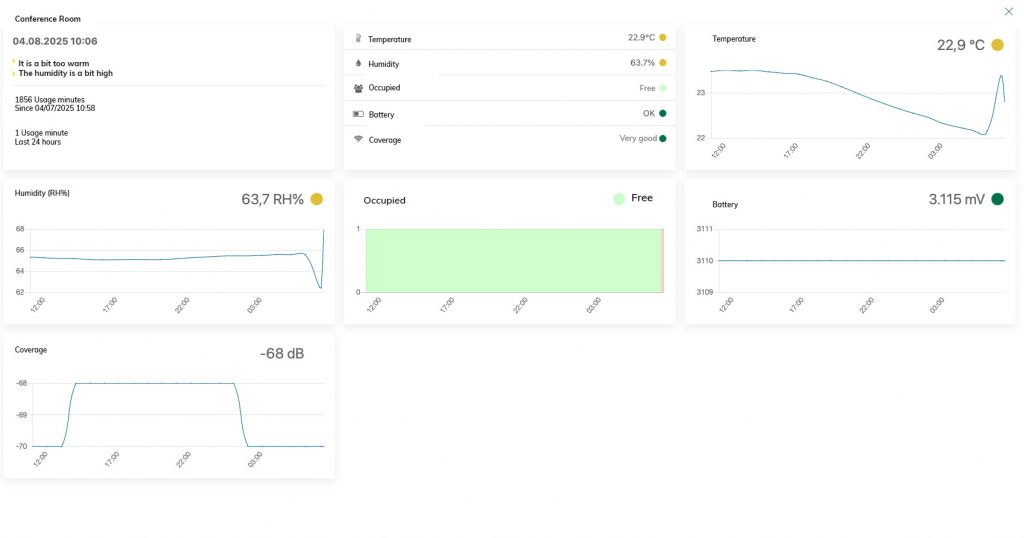
What We Learned
Sensors are a useful tool – but not a solution in itself. Data must be interpreted with care. A room may appear unused in the system, but it might still require cleaning due to crumbs, waste, or spills that the sensor cannot detect.
That’s why it’s important that cleaning staff:
- Understand what the data shows – and what it doesn’t
- Know how to use it in planning
- See the technology as support in their daily work, not as a form of control
The sensors contain no cameras, store no personal data, and do not monitor people. They simply measure activity in the room and provide a basis for decision-making – not a definitive answer.
What Our Test Shows
Our test shows that sensors are not a quick fix, but a valuable supplement. They provide insights into usage patterns that are otherwise difficult to capture in daily operations, and work best when combined with professional judgement and existing digital tools.
Especially in environments with fluctuating traffic, sensor data can contribute to:
- Documentation: Clear data on usage and indoor climate that can be applied in both operations and reporting.
- Planning dialogue: A shared starting point for discussions about needs and resources – based on facts rather than assumptions.
- Data-driven prioritisation: The ability to adjust efforts and focus on the areas with the highest activity.
However, technology cannot stand alone. It does not replace experience and expertise – but it makes it easier to share, qualify, and build on them.
Sensors can be an effective supplement to cleaning schedules – particularly in environments where rooms are used unevenly (e.g. schools, offices, or hospitals).
They can:
- Support demand-based cleaning
- Document the use of areas
- Make planning more concrete and collaborative
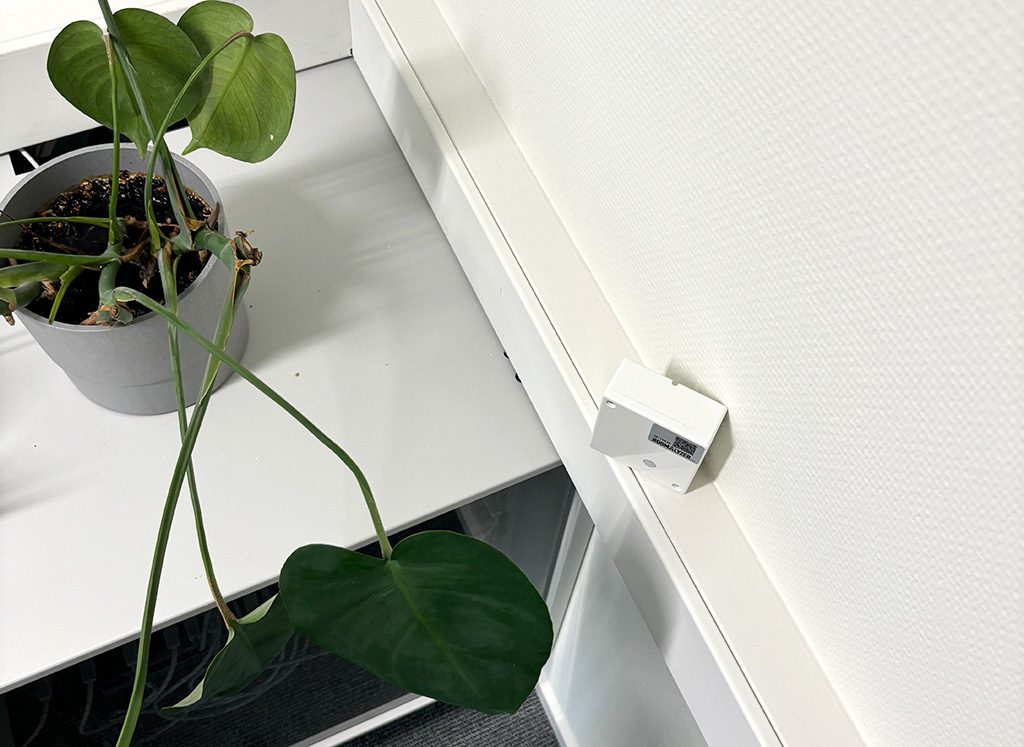
Conclusion: Are Sensors the Right Solution for You?
The short answer: it depends on your needs and environment.
Our experience shows that sensors can be a valuable supplement to cleaning routines, but they are not the right fit for every setting. They gave us better documentation, a more accurate picture of how our spaces were used, and the ability to adjust cleaning schedules so staff could focus their time on the most important tasks. But we also learned that successful implementation requires careful planning, correct placement, and staff involvement. Without these foundations, there is a risk that data may be misunderstood or not used to its full potential.
When Are Sensors a Good Solution?
Sensors work particularly well if:
- Rooms have fluctuating traffic, where usage patterns are difficult to judge through observation alone.
- You want stronger documentation to support dialogue, both internally and with clients.
- You are willing to invest time in implementation – testing placements and introducing staff to using the data.
- You want to relieve staff from spending time on empty rooms so they can focus on quality control and more value-adding tasks.
- You want to offer transparency to clients, for example by using data to demonstrate where and when activity has taken place.
When Are Sensors Less Relevant?
If your facilities are small, uniform, and constantly in use, sensors are unlikely to add much extra value. Data also cannot replace professional judgement – for example, a sensor will not detect crumbs, spills, or the need for an extra clean, even if the system shows the room as unused.
Our Recommendations for Cleaning Companies
If you are considering adopting sensors, keep the following in mind:
- Expect a learning curve – Set aside time to introduce staff to the data, so they understand how it can be used in daily routines. Be prepared for a period where placements and processes may need adjustment.
- Integrate into an overall plan – Sensors cannot stand alone. They need to be used alongside professional assessment and existing routines to create real value.
- Evaluate the benefits – Assess whether data helps you avoid unnecessary tasks or provides stronger documentation, and whether the gains outweigh the effort.
- Consider your facilities – Sensors add most value in areas with varying levels of traffic. Think carefully about where they will make a difference, and where they are unnecessary.
- See them as a supplement – Sensors do not replace experience, but they can strengthen it and make it easier to share. Implementation should happen in close collaboration with staff.
- Think about your clients – Consider whether clients will value documentation of use and cleaning. Data can support service discussions and strengthen both retention and competitiveness.
- Get expert advice – Before scaling up, it may be worthwhile to consult an industry expert or independent specialist to evaluate how sensors can best be applied in your company.
The Benefits and Challenges with Sensors
Benefits of Using Sensors in Cleaning:
More precise cleaning – sensors showed which rooms were actually in use, allowing us to prioritise cleaning more effectively.
Relief for staff – less time spent on empty rooms meant more time for other tasks.
Continuous adjustment – we fine-tuned sensor placement until we achieved the most accurate readings.
Objective documentation – data provided a consistent and reliable basis to support discussions about planning and prioritisation.
Challenges – and How We Solved Them:
Placement is everything – sensors do not register correctly if placed behind furniture or in corners.
Solution: Test different positions and choose one with a clear view of the room’s central areas.
Understanding the data – staff needed time to get used to using the information in their daily routines.
Solution: Involve cleaning staff early and show how data supports their work.
Need for interpretation – not all rooms follow the same patterns, so data must be read in context.
Solution: Combine sensor data with professional expertise to get the full picture.
Ready to Try It Yourself?
Our experience with sensors shows that technology can be a valuable supplement in the cleaning industry, but only when implemented under the right conditions and with a well-thought-out approach.
For cleaning companies looking to optimise planning and documentation, sensors can be an excellent place to start. They provide fact-based insights into how rooms are actually used, making it possible to focus resources where they create the most value. At the same time, working with sensor technology can help attract staff who are interested in digital tools – making your company a more appealing workplace.
Industry experts highlight that data-driven solutions are becoming increasingly important in cleaning. Acting early can help you maintain a competitive edge. Still, the right solution will always depend on your company’s needs, client base, and working environments. A gradual implementation can make it easier to integrate the technology and ensure that it delivers real value without unnecessary risks.
Are sensors relevant for your business? Consider your needs, and test the technology in practice, just as we did.
How to Get Started
Sensors are a technology you can easily test on a small scale:
1. Start small – choose one room (e.g. a meeting room or a canteen).
2. Run a short test – monitor the data for a couple of weeks and compare it with your own experience.
3. Involve staff – explain what the sensor shows and why it matters.
4. Use the data actively – adjust your cleaning plan if you spot new patterns.
You don’t need to change your entire operation at once, one improvement at a time can still make a big difference.
Looking Ahead
At CleanManager, we believe in technology that makes sense in everyday work. It’s not about chasing the newest tools at any cost – it’s about selecting the solutions that create real value for staff, clients, and the business.
Want to know why the cleaning industry can no longer avoid digitalisation? Read our article: Why Technology Has Become Essential for Cleaning Companies.
Curious about our other tests of new tools? Have a look at our robot vacuum case study – another example of how we explore technology to see when it truly creates value for cleaning companies.
While sensors can’t replace experience or professional judgement, our test shows that they can be a valuable supplement for optimising cleaning processes. If your company isn’t ready to invest in more advanced solutions such as robots, sensors can be a straightforward way to gain insights into usage patterns and cleaning needs.
With CleanManager, you can bring planning, documentation, and quality assurance together in one platform – turning data into practical action. Our cleaning company software streamlines administrative tasks and makes it easier to transform insights into real improvements in daily operations.
FAQ: Sensor Technology in the Cleaning Industry
What can sensors be used for in cleaning?
Sensors can measure temperature, humidity, and presence in rooms. They provide fact-based insights into how spaces are actually used, making it possible to adapt cleaning schedules to real needs. This helps cleaning staff save time on empty rooms and focus their efforts where it creates the most value.
How do the sensors work in practice?
The sensors we tested require neither Wi-Fi nor cables. They automatically send data via a low-frequency network and collect the measurements in a simple browser dashboard. This means both cleaning staff and administrators can quickly see where there has been activity – and where cleaning is needed.
Is there a risk of surveillance?
No. The sensors contain no cameras and store no personal data. They only measure room activity and indoor climate – not who is using the space. The data serves as a basis for planning, not as a tool for monitoring staff.
What happens to my data?
All measurements are displayed in an easy-to-read dashboard and stored for reporting. Because the sensors are not dependent on Wi-Fi, data is not lost during internet outages. Administrators can generate reports on usage patterns and indoor climate, while cleaning staff can mark rooms as cleaned directly in the dashboard.
What challenges can sensors present?
Placement matters – if sensors are hidden behind furniture or in corners, the readings may be inaccurate. Staff must also be introduced to using the data actively; otherwise, the information may not be put to use. Sensors are a supplement, not a stand-alone solution, and must be combined with professional expertise.
When do sensors add the most value?
They work best in environments with fluctuating traffic, such as offices, schools, or hospitals, where it can be difficult to judge usage patterns by observation alone. Sensors provide documentation, make discussions about cleaning needs more concrete, and help reduce unnecessary tasks.
Are sensors the right solution for all companies?
Not necessarily. In small spaces that are always in use, sensors add limited value. They are most relevant for companies seeking better documentation, flexible planning, and data-driven insights as a supplement to experience and expertise.
How do you choose the right technology in cleaning?
It’s not about chasing the newest tools at any cost – it’s about selecting solutions that create real value in everyday work for staff, clients, and the business. That’s why we test new technologies in practice before recommending them further.
Are sensors a good first step if we’re not ready for robots?
Yes. Sensors can be a simple, practical way to start working with data-driven operations. They require minimal setup, provide usable insights quickly, and support cleaning staff without changing the entire operation.
Can sensor data be used with CleanManager?
Yes. Although sensors are not part of our product, we see potential in combining sensor data with planning, documentation, and quality assurance in CleanManager. This can give cleaning companies a single overview and make it easier to turn data into action.
